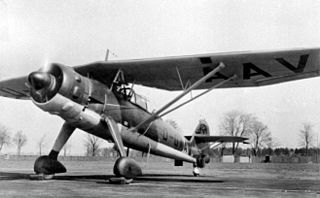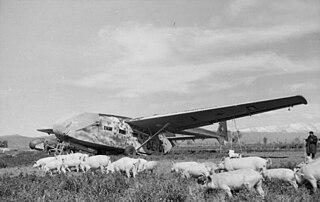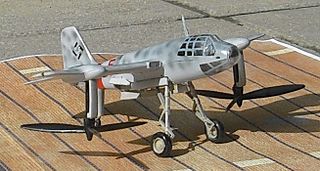
The Focke-Wulf Fw 61 is often considered the first practical, functional helicopter, first flown in 1936. It was also known as the Fa 61, as Focke began a new company—Focke-Achgelis—in 1937.

Focke-Achgelis & Co. G.m.b.H. was a German helicopter company founded in 1937 by Henrich Focke and Gerd Achgelis.

Henrich Focke was a German aviation pioneer from Bremen and also a co-founder of the Focke-Wulf company. He is best known as the inventor of the Fw 61, the first successful German helicopter.

The DFS 230 was a German transport glider operated by the Luftwaffe in World War II. It was developed in 1933 by the Deutsche Forschungsanstalt für Segelflug with Hans Jacobs as the head designer. The glider was the German inspiration for the British Hotspur glider and was intended for airborne assault operations.

The Henschel Hs 126 was a German two-seat reconnaissance and observation aircraft of World War II that was derived from the Henschel Hs 122. The pilot was seated in a protected cockpit under the parasol wing and the gunner in an open rear cockpit. The prototype aircraft frame was that of a Hs 122A fitted with a Junkers engine. The Hs 126 was well received for its good short takeoff and low-speed characteristics which were needed at the time. It was put into service for a few years, but was soon superseded by the general-purpose, STOL Fieseler Fi 156 Storch and the medium-range Focke-Wulf Fw 189 "flying eye".

The Gotha Go 242 was a transport glider used by the Luftwaffe during World War II. It was an upgrade over the DFS 230 in both cargo/troop capacity and flight characteristics. It saw limited combat action. There were multiple variants.

The Focke-Achgelis Fa 223 Drache was a helicopter developed by Germany during World War II. A single 750-kilowatt (1,010 hp) Bramo 323 radial engine powered two three-bladed 11.9-metre (39 ft) rotors mounted on twin booms on either side of the 12.2-metre-long (40 ft) cylindrical fuselage. Although the Fa 223 is noted for being the first helicopter to attain production status, production of the helicopter was hampered by Allied bombing of the factory, and only 20 were built.

The Flettner Fl 282 Kolibri ("Hummingbird") is a single-seat intermeshing rotor helicopter, or synchropter, produced by Anton Flettner of Germany. According to Yves Le Bec, the Flettner Fl 282 was the world's first series production helicopter.

The Focke-Achgelis Fa 330 Bachstelze was a type of rotary-wing kite, known as a rotor kite. They were towed behind German U-boats during World War II to allow a lookout to see further.

The DFS 331 was a transport glider prototype developed in a collaboration between DFS and Gotha. It was a twenty-seat troop transport designed by Hans Jacobs, who had previously produced the successful, nine seat DFS 230.

The Focke-Achgelis Fa 269 was a tiltrotor VTOL aircraft project designed by Henrich Focke.
The Airborne Forces Experimental Establishment (AFEE) was a branch of the British Air Ministry, that researched and developed non-traditional airborne applications, such as gliders, rotary wing aircraft, and dropping of personnel and equipment by parachute, in the period 1942–1950.
The DFS 230F was a military assault glider designed and built in Germany, by Gotha during World War II, to succeed the smaller DFS 230 which it was only related to by name.
The Focke-Achgelis Fa 284 was a project to develop a large transport helicopter, designed in 1943 by Focke-Achgelis for use by the Luftwaffe. The helicopter was powered by two BMW 801 radial engines, driving transversely-mounted rotors, and was equipped with a large, detachable cargo pod for carrying loads.











